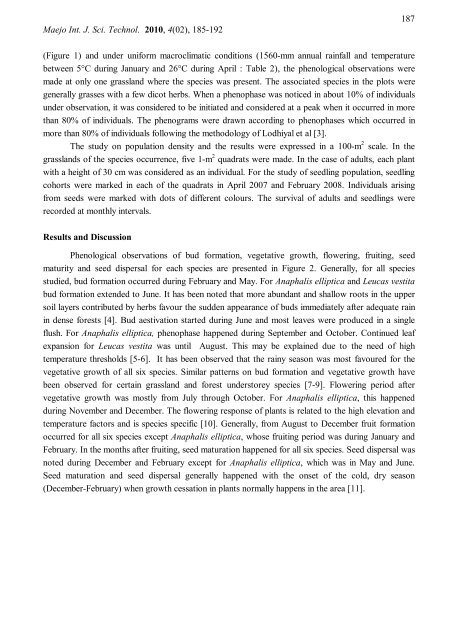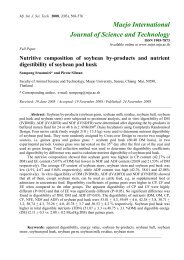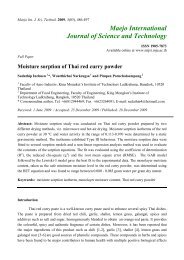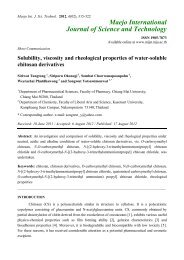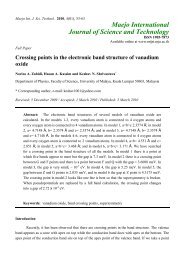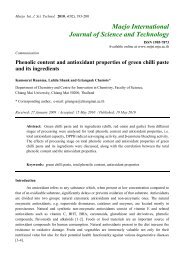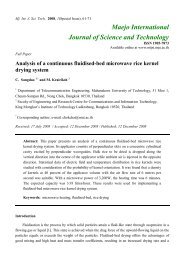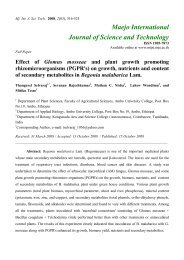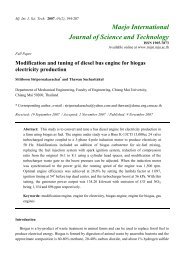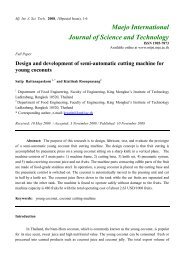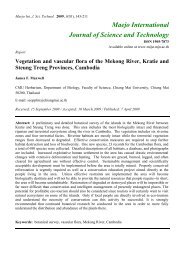Phenological observation and population dynamics of six ...
Phenological observation and population dynamics of six ...
Phenological observation and population dynamics of six ...
You also want an ePaper? Increase the reach of your titles
YUMPU automatically turns print PDFs into web optimized ePapers that Google loves.
Maejo Int. J. Sci. Technol. 2010, 4(02), 185-192187(Figure 1) <strong>and</strong> under uniform macroclimatic conditions (1560-mm annual rainfall <strong>and</strong> temperaturebetween 5C during January <strong>and</strong> 26C during April : Table 2), the phenological <strong>observation</strong>s weremade at only one grassl<strong>and</strong> where the species was present. The associated species in the plots weregenerally grasses with a few dicot herbs. When a phenophase was noticed in about 10% <strong>of</strong> individualsunder <strong>observation</strong>, it was considered to be initiated <strong>and</strong> considered at a peak when it occurred in morethan 80% <strong>of</strong> individuals. The phenograms were drawn according to phenophases which occurred inmore than 80% <strong>of</strong> individuals following the methodology <strong>of</strong> Lodhiyal et al [3].The study on <strong>population</strong> density <strong>and</strong> the results were expressed in a 100-m 2 scale. In thegrassl<strong>and</strong>s <strong>of</strong> the species occurrence, five 1-m 2 quadrats were made. In the case <strong>of</strong> adults, each plantwith a height <strong>of</strong> 30 cm was considered as an individual. For the study <strong>of</strong> seedling <strong>population</strong>, seedlingcohorts were marked in each <strong>of</strong> the quadrats in April 2007 <strong>and</strong> February 2008. Individuals arisingfrom seeds were marked with dots <strong>of</strong> different colours. The survival <strong>of</strong> adults <strong>and</strong> seedlings wererecorded at monthly intervals.Results <strong>and</strong> Discussion<strong>Phenological</strong> <strong>observation</strong>s <strong>of</strong> bud formation, vegetative growth, flowering, fruiting, seedmaturity <strong>and</strong> seed dispersal for each species are presented in Figure 2. Generally, for all speciesstudied, bud formation occurred during February <strong>and</strong> May. For Anaphalis elliptica <strong>and</strong> Leucas vestitabud formation extended to June. It has been noted that more abundant <strong>and</strong> shallow roots in the uppersoil layers contributed by herbs favour the sudden appearance <strong>of</strong> buds immediately after adequate rainin dense forests [4]. Bud aestivation started during June <strong>and</strong> most leaves were produced in a singleflush. For Anaphalis elliptica, phenophase happened during September <strong>and</strong> October. Continued leafexpansion for Leucas vestita was until August. This may be explained due to the need <strong>of</strong> hightemperature thresholds [5-6]. It has been observed that the rainy season was most favoured for thevegetative growth <strong>of</strong> all <strong>six</strong> species. Similar patterns on bud formation <strong>and</strong> vegetative growth havebeen observed for certain grassl<strong>and</strong> <strong>and</strong> forest understorey species [7-9]. Flowering period aftervegetative growth was mostly from July through October. For Anaphalis elliptica, this happenedduring November <strong>and</strong> December. The flowering response <strong>of</strong> plants is related to the high elevation <strong>and</strong>temperature factors <strong>and</strong> is species specific [10]. Generally, from August to December fruit formationoccurred for all <strong>six</strong> species except Anaphalis elliptica, whose fruiting period was during January <strong>and</strong>February. In the months after fruiting, seed maturation happened for all <strong>six</strong> species. Seed dispersal wasnoted during December <strong>and</strong> February except for Anaphalis elliptica, which was in May <strong>and</strong> June.Seed maturation <strong>and</strong> seed dispersal generally happened with the onset <strong>of</strong> the cold, dry season(December-February) when growth cessation in plants normally happens in the area [11].


